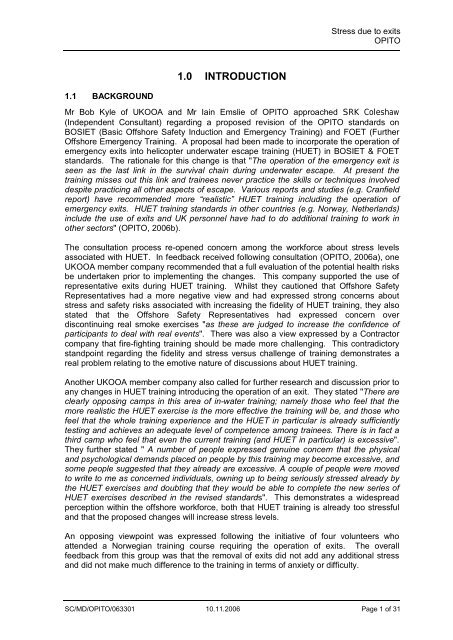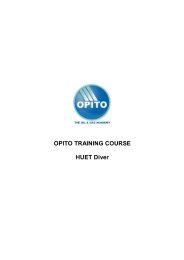Stress levels associated with huet - Opito
Stress levels associated with huet - Opito
Stress levels associated with huet - Opito
Create successful ePaper yourself
Turn your PDF publications into a flip-book with our unique Google optimized e-Paper software.
1.1 BACKGROUND<br />
1.0 INTRODUCTION<br />
<strong>Stress</strong> due to exits<br />
OPITO<br />
Mr Bob Kyle of UKOOA and Mr Iain Emslie of OPITO approached SRK Coleshaw<br />
(Independent Consultant) regarding a proposed revision of the OPITO standards on<br />
BOSIET (Basic Offshore Safety Induction and Emergency Training) and FOET (Further<br />
Offshore Emergency Training. A proposal had been made to incorporate the operation of<br />
emergency exits into helicopter underwater escape training (HUET) in BOSIET & FOET<br />
standards. The rationale for this change is that "The operation of the emergency exit is<br />
seen as the last link in the survival chain during underwater escape. At present the<br />
training misses out this link and trainees never practice the skills or techniques involved<br />
despite practicing all other aspects of escape. Various reports and studies (e.g. Cranfield<br />
report) have recommended more “realistic” HUET training including the operation of<br />
emergency exits. HUET training standards in other countries (e.g. Norway, Netherlands)<br />
include the use of exits and UK personnel have had to do additional training to work in<br />
other sectors" (OPITO, 2006b).<br />
The consultation process re-opened concern among the workforce about stress <strong>levels</strong><br />
<strong>associated</strong> <strong>with</strong> HUET. In feedback received following consultation (OPITO, 2006a), one<br />
UKOOA member company recommended that a full evaluation of the potential health risks<br />
be undertaken prior to implementing the changes. This company supported the use of<br />
representative exits during HUET training. Whilst they cautioned that Offshore Safety<br />
Representatives had a more negative view and had expressed strong concerns about<br />
stress and safety risks <strong>associated</strong> <strong>with</strong> increasing the fidelity of HUET training, they also<br />
stated that the Offshore Safety Representatives had expressed concern over<br />
discontinuing real smoke exercises "as these are judged to increase the confidence of<br />
participants to deal <strong>with</strong> real events". There was also a view expressed by a Contractor<br />
company that fire-fighting training should be made more challenging. This contradictory<br />
standpoint regarding the fidelity and stress versus challenge of training demonstrates a<br />
real problem relating to the emotive nature of discussions about HUET training.<br />
Another UKOOA member company also called for further research and discussion prior to<br />
any changes in HUET training introducing the operation of an exit. They stated "There are<br />
clearly opposing camps in this area of in-water training; namely those who feel that the<br />
more realistic the HUET exercise is the more effective the training will be, and those who<br />
feel that the whole training experience and the HUET in particular is already sufficiently<br />
testing and achieves an adequate level of competence among trainees. There is in fact a<br />
third camp who feel that even the current training (and HUET in particular) is excessive".<br />
They further stated " A number of people expressed genuine concern that the physical<br />
and psychological demands placed on people by this training may become excessive, and<br />
some people suggested that they already are excessive. A couple of people were moved<br />
to write to me as concerned individuals, owning up to being seriously stressed already by<br />
the HUET exercises and doubting that they would be able to complete the new series of<br />
HUET exercises described in the revised standards". This demonstrates a widespread<br />
perception <strong>with</strong>in the offshore workforce, both that HUET training is already too stressful<br />
and that the proposed changes will increase stress <strong>levels</strong>.<br />
An opposing viewpoint was expressed following the initiative of four volunteers who<br />
attended a Norwegian training course requiring the operation of exits. The overall<br />
feedback from this group was that the removal of exits did not add any additional stress<br />
and did not make much difference to the training in terms of anxiety or difficulty.<br />
SC/MD/OPITO/063301 10.11.2006 Page 1 of 31




